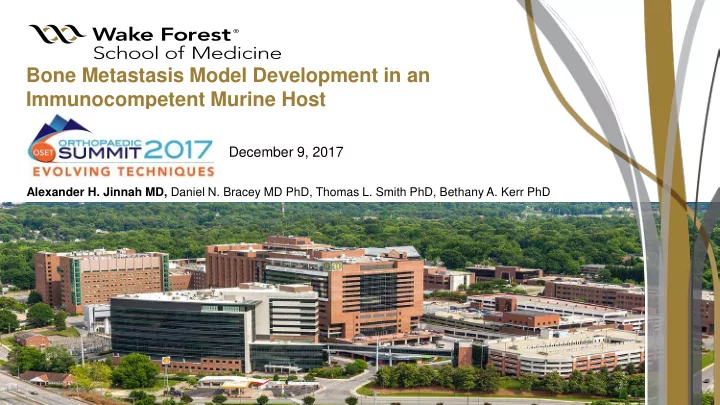

Bone Metastasis Model Development in an Immunocompetent Murine Host December 9, 2017 Alexander H. Jinnah MD, Daniel N. Bracey MD PhD, Thomas L. Smith PhD, Bethany A. Kerr PhD
Background • Prevalence of bone metastasis is 280,000 in US • Serious skeletal complications • Hypercalcemia, spinal cord compression, bone pain, pathological fractures • Survival after bone metastasis diagnosis is ~ 2 years Li et al. 2012 Thibaudeau et al. 2014 Holen et al. 2015 Wake Forest Baptist Medical Center 2
Background • Treatment strategies consist of: • Chemotherapy • Immunotherapy Will not cure – will • Radiopharmaceuticals only treat symptoms • Bisphosphonates • Surgery Wake Forest Baptist Medical Center 3
? Lack of an appropriate in vivo models Current Models: 1. Direct injection 2. Intracardiac Injection Wake Forest Baptist Medical Center 4
Purpose To create an in vivo bone metastasis model in an immunocompetent host using a decellularized porcine xenograft Wake Forest Baptist Medical Center 5
Methods • Decellularized xenograft was created using porcine femurs Wake Forest Baptist Medical Center 6
Methods • To determine osteoblast viability and osteoinductive potential - Pre-osteoblasts were seeded on the scaffold • Incubated for 1 week with and without ascorbic acid • Analyzed for gene expression (qPCR) of Alkaline Phosphatase and BMP-7 Cells + Ascorbic Acid Cells No Ascorbic Acid Scaffold + Ascorbic Acid Scaffold No Ascorbic Acid Wake Forest Baptist Medical Center 7
Methods • To determine prostate Ca viability on scaffold – prostate cancer cells were seeded on the scaffold • Incubated for 1 week • Analyzed for gene expression (qPCR) of mTor, SOX-2 and RANKL Prostate Ca Cells Scaffold + Prostate Ca. Cells Wake Forest Baptist Medical Center 8
Methods • To determine osteoblast viability and osteoinductive potential in vivo • Pre-osteoblasts seeded scaffolds and unseeded scaffolds were implanted subcutaneously on the dorsum of a mouse • Explanted scaffolds were analyzed for gene expression (qPCR) of Wnt3a, BMP-2, and OSX • 5 seeded and 5 unseeded were microCT scanned • Histological and Immunohistochemistry Analysis Wake Forest Baptist Medical Center 9
Results Wake Forest Baptist Medical Center
Pre-osteoblasts In-vitro Alkaline Phosphatase BMP-7 BMP-7 80 40 Relative to control Normalized to 18S Gene Expression 10 8 Control 6 + Ascorbic 4 2 0 Scaffold Monolayer • Increased Alkaline phosphatase expression in scaffold Ascorbic acid lead to further increase in expression • No significant differences seen in BMP-7 Wake Forest Baptist Medical Center 11
Cancer Cells In-Vitro • mTor and sox-2 gene expression were significantly higher in the scaffold than the control monolayer • Suggests cancer cell proliferation Wake Forest Baptist Medical Center 12
Cancer Cells In-Vitro In-Vitro • RANKL gene expression was significantly higher in the scaffold than the control monolayer • Suggests osteoblast activity Wake Forest Baptist Medical Center 13
Pre-osteoblasts In-vivo BMP-2 * 200 100 Relative to control Normalized to 18S Gene Expression 10 cells 8 No cells 6 4 2 0 k wnt3a * 2000 • gene expression was 1000 Relative to control Normalized to 18S Gene Expression significantly greater in all 5 4 cells groups 3 No cells 2 1 0 Wake Forest Baptist Medical Center 14
Pre-osteoblasts In-vivo • MicroCT Scans were performed on 8 of 10 scaffolds due to inadequate pre-implantation scans • 2 more were excluded based on inadequate post- implantation scan or partial destruction of the scaffold • Increase in bone volume and trabecular thickness post- implantation (ns) Trabecular Thickness 5 4 Average Tb.Th Fold change 3 2 Pre Implantation 1 Post Implantation 0 Scaffold Scaffold + OB Wake Forest Baptist Medical Center 15
Histological Analysis • H&E staining demonstrating cellular material accumulating within the scaffold • IHC staining demonstrated that these cells express osteopontin • Pentachrome staining demonstrating new collagen formation within the pores Wake Forest Baptist Medical Center 16
Conclusions Wake Forest Baptist Medical Center
Conclusions • Osteoinductive potential of decellularized porcine xenograft • Decellularized xengoraft is a viable host to osteoblasts in vivo and in vitro and to cancer cells in vitro Future Work • Implant scaffold and a tumor into immunocompetent mouse • PET-CT Wake Forest Baptist Medical Center 18
Wake Forest Baptist Medical Center 19
Recommend
More recommend